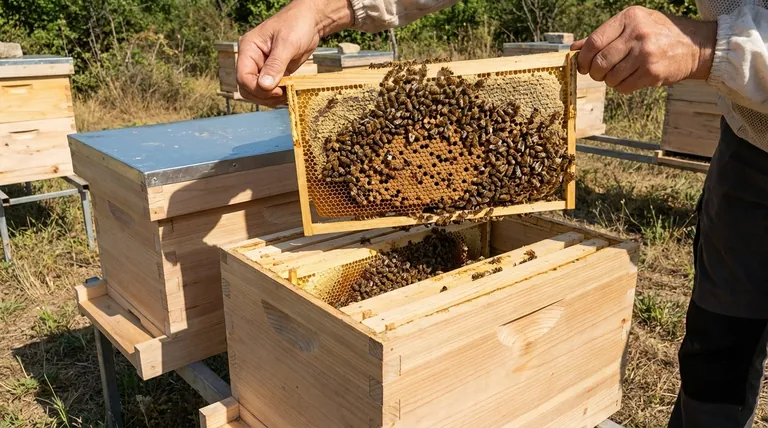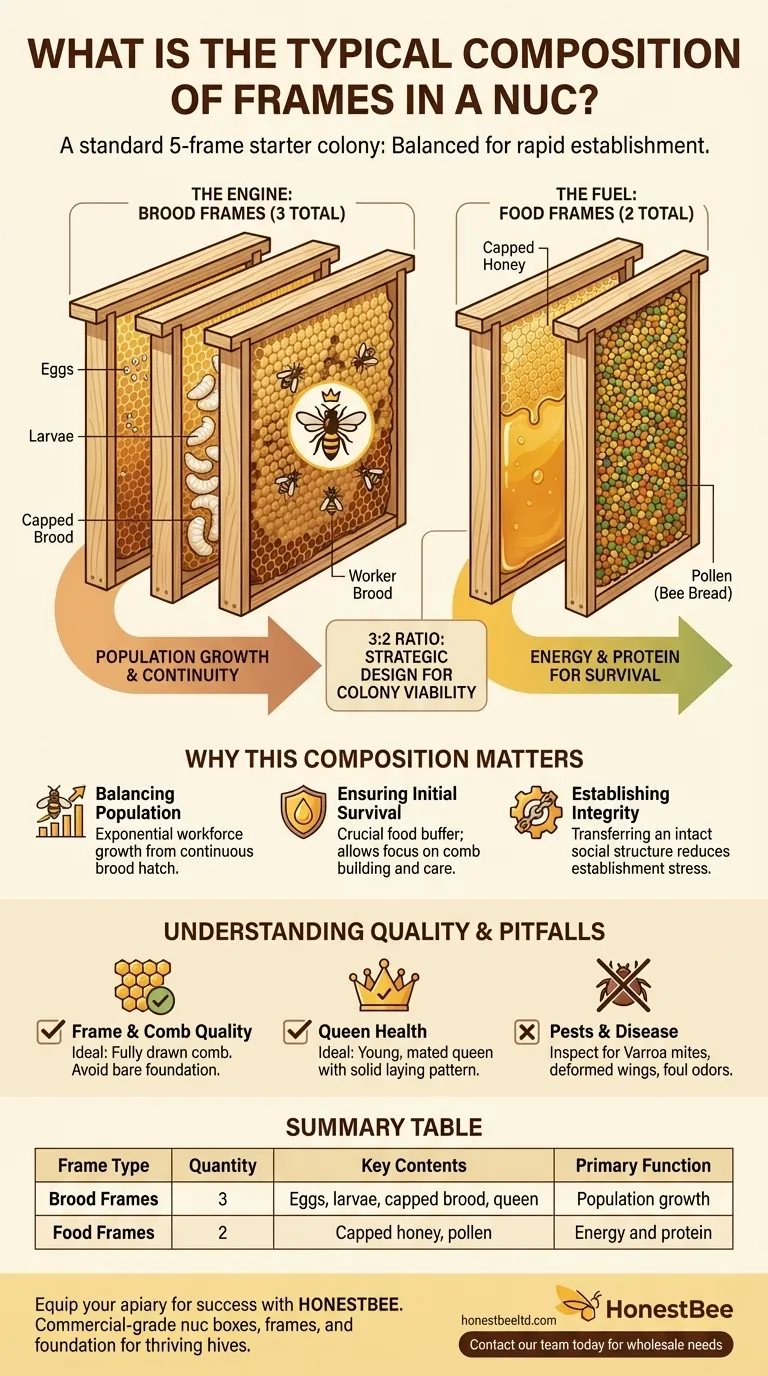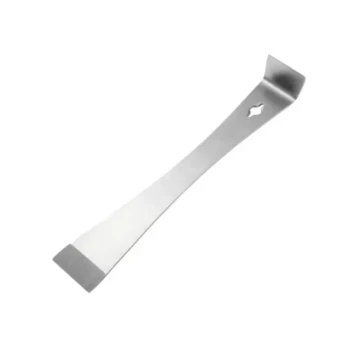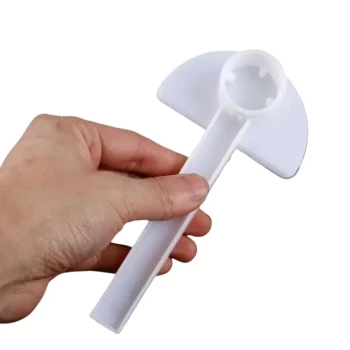A standard nucleus hive, or nuc, is composed of five frames. This configuration is not arbitrary; it is a carefully balanced starter colony, with three frames typically dedicated to brood and two frames containing food stores like honey and pollen.
A nuc is engineered to be a complete, miniature colony. Its specific frame composition provides the perfect balance of an active workforce (brood) and essential resources (food) to ensure rapid, successful establishment in a new hive.

The Anatomy of a Nuc: A Frame-by-Frame Breakdown
Understanding the role of each frame is critical to assessing a nuc's quality and potential. The 5-frame structure is a proven blueprint for colony viability.
The Engine of the Colony: The Brood Frames
The three central frames form the core of the new colony's population and future growth. A quality nuc will have frames containing brood in all stages of development.
This includes eggs, tiny white specks indicating a recently active queen; larvae, the developing grubs being fed by nurse bees; and capped brood, where pupation occurs. The presence of all stages confirms you have a healthy, currently laying queen.
The queen herself will be located on one of these three frames, surrounded by her attendants.
The Fuel for Growth: The Food Frames
The two outer frames serve as the colony's pantry, providing the necessary resources to survive the transition and fuel initial expansion.
These frames should be heavy with capped honey, which provides carbohydrates for energy. They should also contain stores of pollen, often called "bee bread," which is the critical protein source used to feed developing larvae.
These food reserves ensure the colony does not starve while it orients to its new location and establishes foraging patterns.
Why This Specific Composition Matters
The 3-to-2 ratio of brood to food is a strategic design intended to maximize the probability of success. It directly addresses the most significant challenges a new colony faces.
Balancing Population and Resources
The three frames of brood provide a continuous "hatch" of new worker bees. This ensures the population can grow exponentially, quickly building the workforce needed for foraging, defense, and hive maintenance.
Ensuring Initial Survival
A nuc is most vulnerable immediately after being installed. The two frames of food provide a crucial buffer, allowing the bees to focus on building comb and caring for brood without the immediate, desperate pressure to find nectar and pollen.
Establishing Colony Integrity
By placing the frames together in a new hive, you are transferring an intact social structure. The bees, frames, and queen already function as a cohesive unit, which dramatically reduces the stress of establishment compared to installing a loose package of bees.
Understanding Quality and Common Pitfalls
Not all nucs are created equal. Knowing the ideal composition allows you to identify red flags and assess the true value of what you are receiving.
Frame and Comb Quality
The ideal nuc contains frames with fully drawn comb. Be wary of nucs that include frames of bare foundation, as this requires the colony to expend significant energy to build out wax before the queen can lay or bees can store food.
The Health of the Queen
The success of the entire colony rests on its queen. A high-quality nuc will have a young, mated queen laying in a solid, consistent pattern. A spotty or inconsistent brood pattern can be a sign of an old, failing, or poorly mated queen.
Pests and Disease Pressure
Always inspect a nuc for signs of pests or disease before you purchase or install it. Look for evidence of varroa mites, deformed wings on bees, or foul odors from the brood, which can indicate serious underlying health issues.
Making the Right Choice for Your Goal
With a clear understanding of a nuc's composition, you can make informed decisions whether you are buying, splitting, or installing a colony.
- If your primary focus is buying a quality nuc: Verify it has at least three frames of brood in all stages and two frames with significant honey and pollen to ensure you're getting a viable, self-sufficient colony.
- If your primary focus is creating your own nuc (a "split"): Replicate the 3:2 ratio by selecting frames of eggs, larvae, and capped brood along with ample food stores to give your new colony the best possible start.
- If your primary focus is installing a nuc: Place the five frames together in the center of your hive box, keeping them in their original order to maintain the integrity of the brood nest and reduce colony stress.
Understanding the strategic composition of a nuc empowers you to assess its quality and ensure its successful transition into a thriving hive.
Summary Table:
| Frame Type | Quantity | Key Contents | Primary Function |
|---|---|---|---|
| Brood Frames | 3 | Eggs, larvae, capped brood, the queen | Population growth and colony continuity |
| Food Frames | 2 | Capped honey, pollen (bee bread) | Energy and protein for initial survival and growth |
Equip your apiary for success with HONESTBEE.
A strong start is critical for any beekeeping operation. Our wholesale-focused supply of durable, commercial-grade nuc boxes, frames, and foundation is designed to support the precise 5-frame composition that ensures colony viability. We supply the reliable equipment that commercial apiaries and distributors need to build and manage thriving hives efficiently.
Contact our team today to discuss your wholesale needs and ensure your colonies have the foundation for growth.
Visual Guide

Related Products
- 5 Frame Wooden Nuc Box for Beekeeping
- Plastic Transporting Bee Packages and Nuc Boxes for Beekeeping
- HONESTBEE Professional Long Handled Hive Tool with Precision Cutting Blade
- HONESTBEE Advanced Ergonomic Stainless Steel Hive Tool for Beekeeping
- HONESTBEE Professional Multi-Functional Hive Tool with Ergonomic Wood Handle
People Also Ask
- How many frames does a typical wooden nuc box hold? A Guide to Choosing the Right Size
- What are the benefits of starting a new bee colony in a nuc box? Boost Colony Success with Efficient Beekeeping
- How should the nuc be installed in the apiary? Ensure Colony Success from Day One
- What is a common feature of many 5-frame nuc boxes? The Integrated Feeder for Efficient Colony Growth
- What frames should be moved into the queenless hive when requeening with a nuc? Ensure a Successful Queen Introduction



















